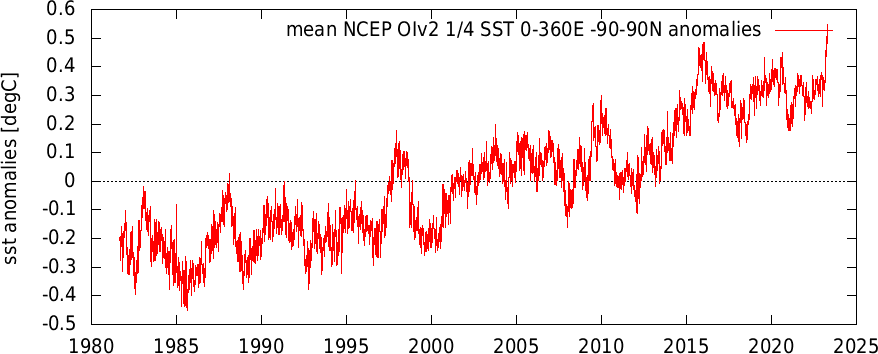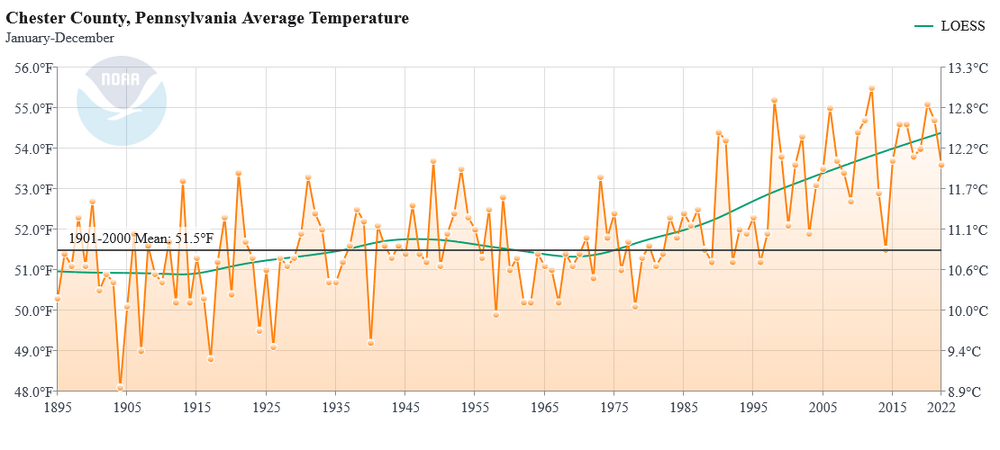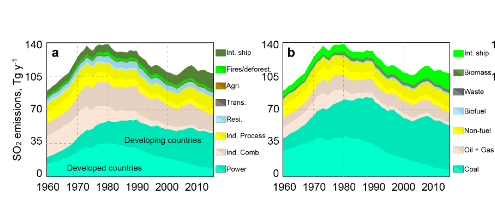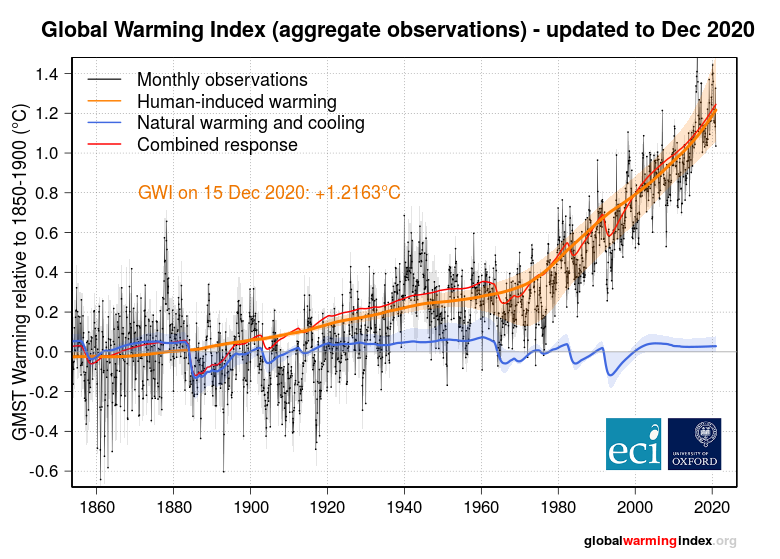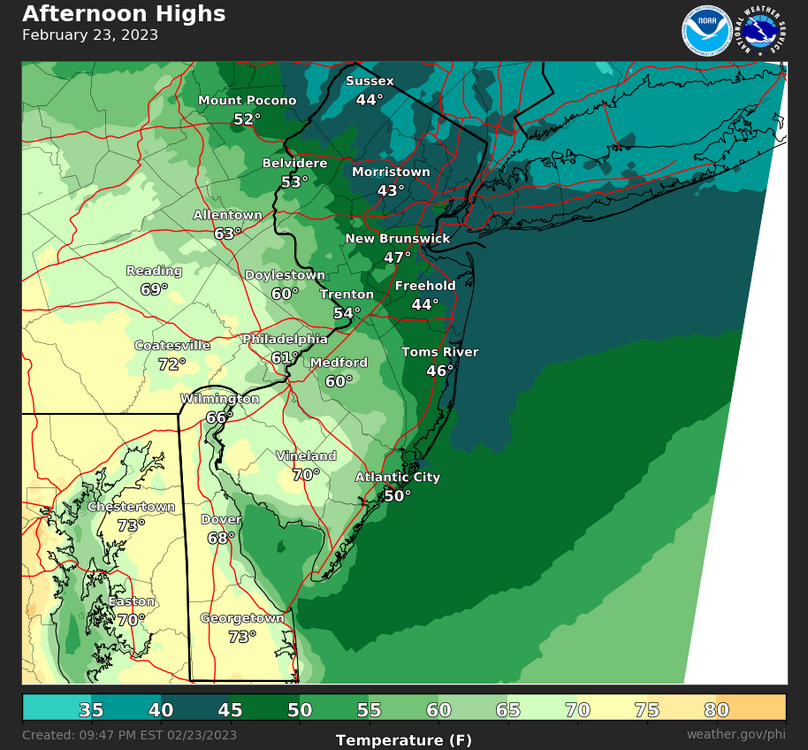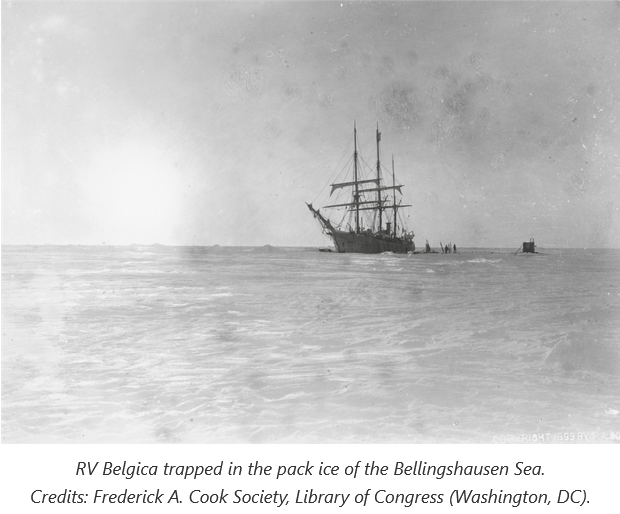
chubbs
Members-
Posts
3,910 -
Joined
-
Last visited
Content Type
Profiles
Blogs
Forums
American Weather
Media Demo
Store
Gallery
Everything posted by chubbs
-
-
Satellite daily global SST anomaly through April 28. The current SST spike is roughly as large as previous anomaly spikes for an entire nino. Looks unprecedented in terms of size and short duration.
-
I've been measuring temperatures locally for for 40 years, trust me its warming. Its warming faster at your house than the "actual data" you have posted in this thread. All the technically sound analyses of local data show strong warming. You are the only guy who thinks it was warmer in the 1940s than current in this area. If you think you have a better analysis than the experts publish your data in a technical forum - challenge the experts.
-
Don't try to speak for me, If analyzed properly. the Chester County COOP data fully supports consensus climate science. Living here for 40 years I can attest to the county's strong warming trend. Like I have said before. You are going to be the last person to detect local warming using observations.
-
Here is a plot of the decade temperatures from Chesco's table. Much more of a shotgun blast than the long-term climate sites. The coop stations have decade-to-decade changes which are much larger than the climate trend, which makes finding the climate signal difficult using raw station data. Note also that many coop stations had big temperature drops from the 1940s to the 1960s or 1970s as stations were modernized. One source of error before modernization is the coop use of mercury max/min thermometers which were subject to time of day bias. Stations with hourly reporting avoided this error. Fortunately there are many local stations and the coop stations were modernized at different times, so station updates are easily identified and corrected by comparing nearby stations using bias adjustment software. Of course, if you don't want to find the climate signal by all means use the raw coop data.
-
The Philadelphia airport is also in good agreement with the other major climate sites in the Mt Holly region. Isn't it strange that all these sites have the same heat island effect?
-
Its more than the bias adjustment. Coatesville raw data (3 separate stations) has exactly the same warming rate as the Philadelphia airport since 1970, roughly3.5F. You have obscured the warming by mixing in poor quality stations and changing the station mix from decade to decade. Including adding in your own house (EN), which you picked for its cold, snowy location.
-
Shows how misleading your analysis is. Per NOAA Chester County has warmed by roughly 3.5F since the 1890s. Note that the Philly obs moved to the airport in 1940, so there is less heat island impact at the end of the Philly record than the beginning.
-
Report: Another Year of Record Heat for the Oceans
chubbs replied to donsutherland1's topic in Climate Change
Agree that the marine sulfur rules contribute to warming, but not convinced they are currently a major factor considering all the other factors contributing to warming. Global SO2 emissions peaked around 1980, as air pollution became an increasing concern. So declining SOx has been contributing to increased forcing for a while; and, we'd have a big forcing imbalance today even if marine sulfur emissions were uncontrolled. I'm betting on the reduction in nina-related upwelling as being the major cause of the recent SST spike. In any case we are going to have to overcome declining SOx emissions going forward. That's the Faustain bargain. -
Report: Another Year of Record Heat for the Oceans
chubbs replied to donsutherland1's topic in Climate Change
This is not a technically sound analysis. SO2 has a few days to two week lifetime, so the impact of the marine sulfur regulation would have been felt quickly in January 2000. The timing is off for the recent spike in SST to be closely associated with ship SOx emissions. -
More BS from JB. You are on the right track with #2, Sulfate and other aerosols offset the warming impact of CO2 and GHG before 1970. Since 1970 man-made climate forcing and global temperatures have ramped together. Very close correlation between net man-made forcing and global temperature (and SST).
-
Global Average Temperature and the Propagation of Uncertainty
chubbs replied to bdgwx's topic in Climate Change
Ooops, first posting had 20-year running average instead 30-year as labeled. I have subbed in the 30-year values. Doesn't change the major trends. -
Global Average Temperature and the Propagation of Uncertainty
chubbs replied to bdgwx's topic in Climate Change
30-year running average snowfall for some Northeast sites, focusing on I95. Plotted on a log scale, to highlight percentage changes between sites. Table below shows changes in current 30-year mean vs mean in 1970, 1990 and 2000. The sites with the lowest snow are in decline. Further north the picture is mixed, coastal I95 has increased at the expense of the interior. I'd expect declining snow to spread slowly and unevenly north with time. Note that we only have snowfall information for our cooler past. -
Global Average Temperature and the Propagation of Uncertainty
chubbs replied to bdgwx's topic in Climate Change
My two cents - That depends on us. Feasible to get off fossil fuels in the next three decades, which would end the warming. More foot dragging--> less winter -
Global Average Temperature and the Propagation of Uncertainty
chubbs replied to bdgwx's topic in Climate Change
Meh. In the long-term CO2 concentrations are going to turn around and head back to 280 ppm no matter what our cumulative economic production is. -
This reflects properties of ice and water. In winter ice is thick, not much heat escapes through the ice, and arctic ocean acts like land with large temperature swings (same for early Spring). Water with ice in it has a temperature near the freezing point of water. One ice cube is enough to maintain near 32F water in a glass of ice water. Adding heat in summer results in less Arctic sea ice; but, as long as some ice remains the ocean water temperature stays near the freezing point of water, so arctic ocean temperature swings are much smaller in summer than in winter. In fall there is more open water to freeze with warming and freezing releases heat; and, ocean water has stored more solar energy due to darker surface in summer with less ice and/or wetter ice. So makes sense that fall warms faster than spring.
-
The warming is strongest in eastern enso regions 1+2, and 3. Per models will take a couple of months for 3.4 to reach 0.5C. There has also been warming of the tropical and sub-tropical Pacific outside the enso regions. Unusual to break SST records this early in a nino.
-
-
E PA/NJ/DE Winter 2022-2023 OBS Thread
chubbs replied to Ralph Wiggum's topic in Philadelphia Region
-
E PA/NJ/DE Winter 2022-2023 OBS Thread
chubbs replied to Ralph Wiggum's topic in Philadelphia Region
71.8F here. I broke the Chester County record. -
-
You are demonstrating your lack of knowledge. The ocean changes slower than land because heat can mix to great depths in the ocean resulting in vast heat capacity. Almost all the energy in the climate system is stored in the ocean. If the ocean is warming, heat energy is coming into the climate system faster than it is going out. I'll let you try to figure out why. Good luck avoiding warming in Chester county under the current circumstances. Per chart below, Chester county is warming like the rest of the world, but a little noisier and faster, as expected based on its mid-latitude land location. Its going to take roughly 1000 years for the entire ocean to equilibrate once the CO2 concentration stops rising. That's why your “cooling cycle” prediction in this decade is so laughable.
-
Global Average Temperature and the Propagation of Uncertainty
chubbs replied to bdgwx's topic in Climate Change
Nice set of posts. Shows how predictable the global mean temperature is and how strong the signal to noise ratio is for greenhouse gas warming. -
I can't find any supporting information for Paul's contention that Chester County temperatures are the same now as the 1930s+1940s. There are a number of problems in his analysis: 1) he has different stations in different decades, 2) The decade averages can be misleading vs looking at all the 10-year averages, 3) The last data point is 2010-19 and warming continues, 4) Most importantly the raw Coop data is noisy and biased, more on that below. The individual coop stations don't agree amongst themselves. Below are 3 stations that cover the entire period (Coatesville is used in Chescowx series). The 30-40s are not unambiguously as warm as today: Coatesville is warmer today. Note also that trends in individual stations are not the same when all 10-year averages are plotted vs just the decade averages. The lack of agreement among these stations is due to the numerous station changes and moves (the breakpoints discussed by bdgwx). That's why bias adjustment is needed. Otherwise the most erratic stations, like West Chester and Phoenxville skew the result. Unlike the coop stations the NWS regional climate sites are all in good agreement with each other. See plot upthread for other regional sites that agree with Allentown and philly airport. All of these stations show strong warming since the 1940s (no data available for 1930s). The raw data from the regional sites disagrees with the coop raw data, but agrees well Coop bias adjusted data. With bias adjustment, the temperature trends in Chester County are not different than the region as a whole (compare SE Pa and Coatesville) or even the global temperature chart posted by bdgwx. The 30s and 40s are warmer than surrounding decades, but much cooler than today. No you can't avoid warming by living in Chester County. With proper analysis there is no evidence that Chester County is as warm now as the 30s or 40s. No evidence that I am aware of anyway.
-
https://www.theonion.com/climate-change-deniers-present-graphic-description-of-w-1819578104


